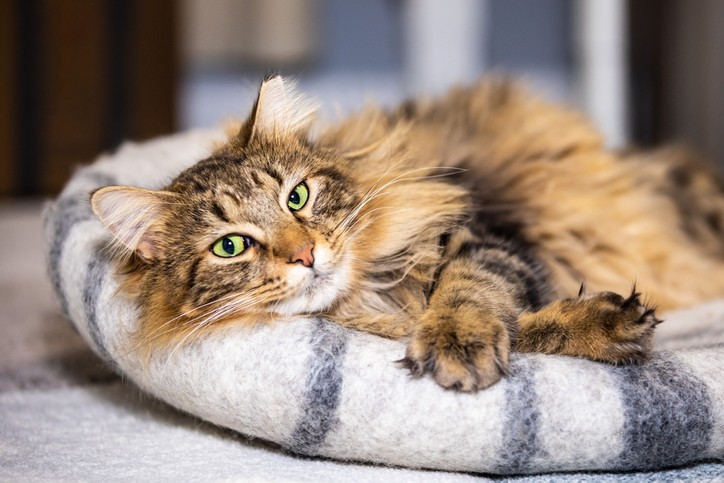
Cat Arthritis: What it is and How to Help Your Pet
Has your cat been diagnosed with arthritis? If you have an older cat, you may have recently been told they are suffering from feline arthritis. This is not an uncommon problem in aging cats, but it is something you can help your pet manage throughout the rest of their life.
With the help of the information in the article below, you can find some useful methods for helping your cat deal with the symptoms of this condition. Read through this list to get some ideas and be sure to talk to your veterinarian if you have any other questions or concerns.
What is Arthritis in Cats?
Arthritis in cats is very similar to the same condition in humans. The term “arthritis” refers to swelling and inflammation of the joints. The older the cat (or human), the worse the pain and stiffness associated with this inflammation become.
Cats may be in more pain than they let on from this condition. Many cats try to hide their pain from their human family members, so you’ll need to learn how to recognize the subtle cues that something is wrong with your cat.
Symptoms of Feline Arthritis
If your cat is showing any of these symptoms it would be best to talk with your veterinarian about arthritis.
Unwillingness to Jump
Cats who have arthritis have trouble jumping. They may no longer be able to jump the way they used to, or they may not be willing to try.
Lack of Grooming
If your cat has arthritis, they may not be able to move around as well as they once did. Because of this, your cat may not be capable of properly self-grooming anymore. Cats with arthritis may get matted fur in areas they cannot reach as easily, such as the hips and hindquarters.
Stiffness After Sleeping
Arthritis frequently causes stiffness upon waking up. If your cat has been sleeping in the same position for a long time, you may notice them having some trouble or taking their time when they get up again later.
Limping
Limping usually means your cat is in quite a lot of pain. Since cats like to hide their pain, it takes a while for them to be willing to show it outwardly like this.
Trouble Using the Litter Box
Cats may have difficulty squatting to use the litter box when they have arthritis.
Aggression or Fear
If your cat is in pain, they may show signs of aggression or fear, especially when someone tries to pet or pick them up.
How to Help Your Cat with Arthritis
There are different options your veterinarian may recommend to help your cat with their arthritis pain.
Laser Therapy and Acupuncture
Laser therapy treatments are pain-free and the gentle, warming feeling can be relaxing for your cat. Acupuncture is also a pain-free treatment used to help the body heal itself. Both laser therapy and acupuncture treatments can help to reduce the inflammation and pain the arthritis is causing.
Pain Medication
Pain medication can go a long way toward helping your cat feel better daily. Cats who take regular daily medication for arthritis pain generally have a better quality of life for longer than those who do not.
Supplements
Talk with your veterinarian about fish oil or joint supplements which could help your pet manage their arthritis.
Orthopedic Bed
An orthopedic bed may help your cat feel less pain and stiffness upon waking up. Choose your cat’s bed carefully and be sure to pick one that is warm enough for your feline friend while they are sleeping, too. Pick a bed with at least one low side for easy entry.
Weight Loss
If your cat is overweight, they may need to lose some weight to help manage their joint pain. Your vet can give you more information about safe weight loss options for aging cats with limited mobility. If your cat is already a healthy weight, this option may not pertain to them.
Ramps
Give your cat some ramps to help them access parts of the home they like best. If they like to lay on the bed with you at night, or if they have a specific window they lay in most of the time, ramps can help them continue accessing these areas even when dealing with joint pain.
Easy Accessibility to Needed Items
Keep all your cat’s needed items—food, water, toys, litter, and bedding—on the same floor of your home. In advanced cases of arthritis, try keeping all these items in the same room so your cat doesn’t have to travel as far.
Your Vet Can Help with Your Cat’s Arthritis
There’s a lot to learn when you have a cat who is diagnosed with arthritis. By taking your time and educating yourself on your cat’s health changes and needs, you can provide a safer, happier environment for your feline friend during the remainder of their life.
Your vet will be a crucial resource for you during this time in your cat’s life. The vet can help you monitor your cat’s condition and make changes as needed to help their arthritis pain. With the help of your vet, you can manage your cat’s condition successfully.
Book an appointment online today to talk with Boston Veterinary Clinic about your cat’s arthritis.